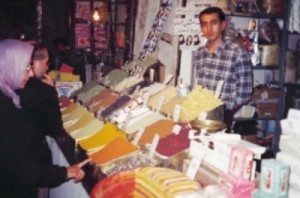
In June 2002, the Ministry of Culture and Islamic Guidance invited me to Iran as a member of the organizing committee for the First International Conference on the Ancient Cultural Relations Between Iran and West Asia, scheduled for August 2003. Following our work, we went to Kermanshah on a three-day trip that gave us a chance to appreciate both the ancient sites and the present-day market. Nassrollah Islami writes in Persian Cooker, “Persians’ cooking is not only appreciated by the Middle Easterners, but it has recently attracted the Western part of the world too. Because a
Persian housewife spends most of her time in the kitchen, and by practicing the theories she has inherited from her ancestors, therefore she, by habit, knows how to cook to give a particular touch to the food and how to encourage her guest to appreciate her cooking.
“…As we say ‘If you watch your husband’s stomach, he will be as harmless as a lamb.’”
Naomi A. Miller, a senior research scientist in MASCA, first worked in Iran in the 1970s, at Malyan. Her professional work on Iranian civilization has also manifested in learning to cook many Iranian culinary favorites, like rice dishes based on the basic recipe here, herb-rich stews (khoreshts), and kabobs.
CHELO
2-1/2
cups rice (basmati is best)
1-1/2
tablespoon salt
2 quarts water + 2
tablespoons salt
1/2 cup butter (or 1/4 cup butter)
1 peeled and thinly
sliced small potato
(mixed with 1/4 cup olive oil)
1. Rinse rice three times in cold water to remove extra starch.
2. Add 2 quarts water and 2 tablespoons salt to rinsed rice.
3. Boil rice until it is half cooked, or a little harder than al dente, about 5 –10 minutes. Stir rice with a spoon once or twice to prevent the grains from sticking together.
4. Strain rice and rinse with lukewarm water.
5. Put 1/3 of the melted butter on the bottom of the same pot in which rice was cooked; add 2 tablespoons water to the butter. Arrange potato slices in a single layer on the bottom of the pot, over the butter-water mixture, to make tadig, the golden crisp crust that will form at the bottom of the pot.
6. One spoonful at a time, put the rice back in the pot, distributing it evenly. Allow it to mound into a conical shape. Using the round handle of a wooden spoon, poke steam holes vertically into rice mound, all the way to the bottom of the pot, to increase the surface area for steaming and cooking the rice. Drizzle the rest of the melted butter evenly over the rice.
7. Put a clean cotton dishcloth over the pot and cover with the lid so that the cloth is held tightly over the rice cone to absorb excess water as it steams up while cooking (Iranian rice grains should not stick to each other). Make sure the dishcloth corners do not hang down near the fire. Cook 15 minutes on medium fire. Then cook 35 – 40 minutes on the lowest setting possible. At the right temperature, the potatoes will form a crust — the tadig. Carefully spoon out rice into serving platter. Use a spatula to loosen and remove crust from bottom of pot and place it on its own serving plate, golden side
